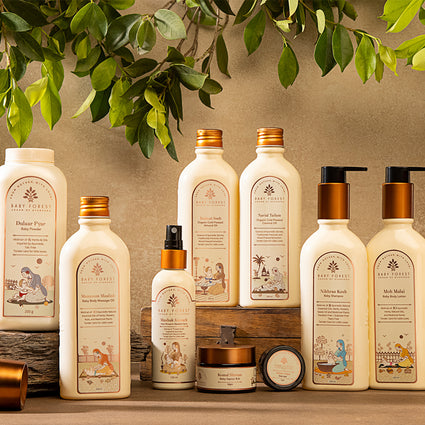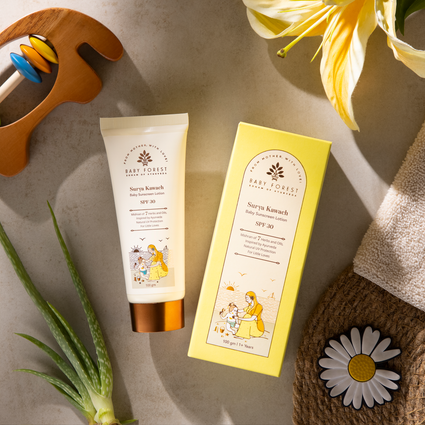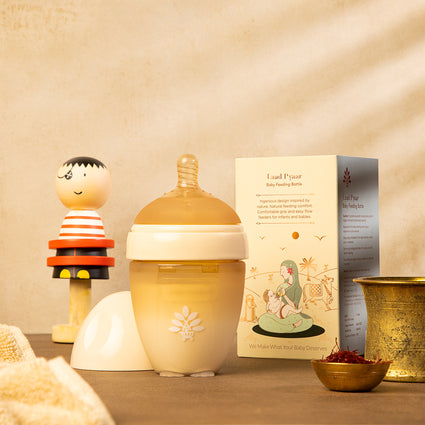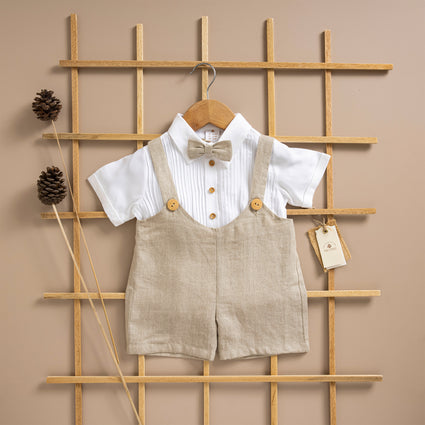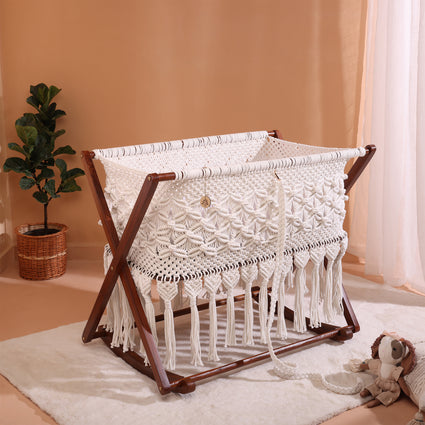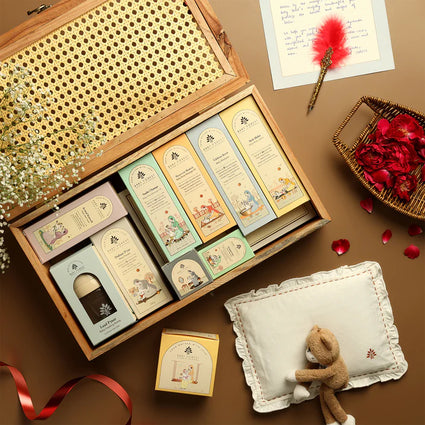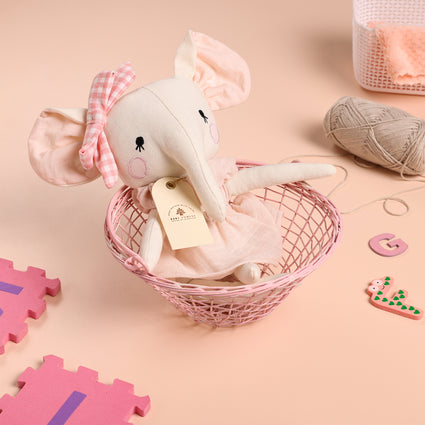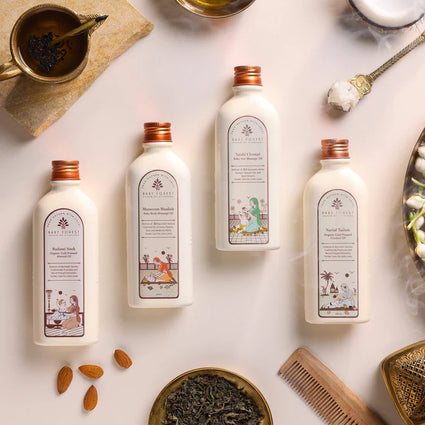Baby Care & Parenting Blogs

6 Ways to Boost Your Child's Imagination
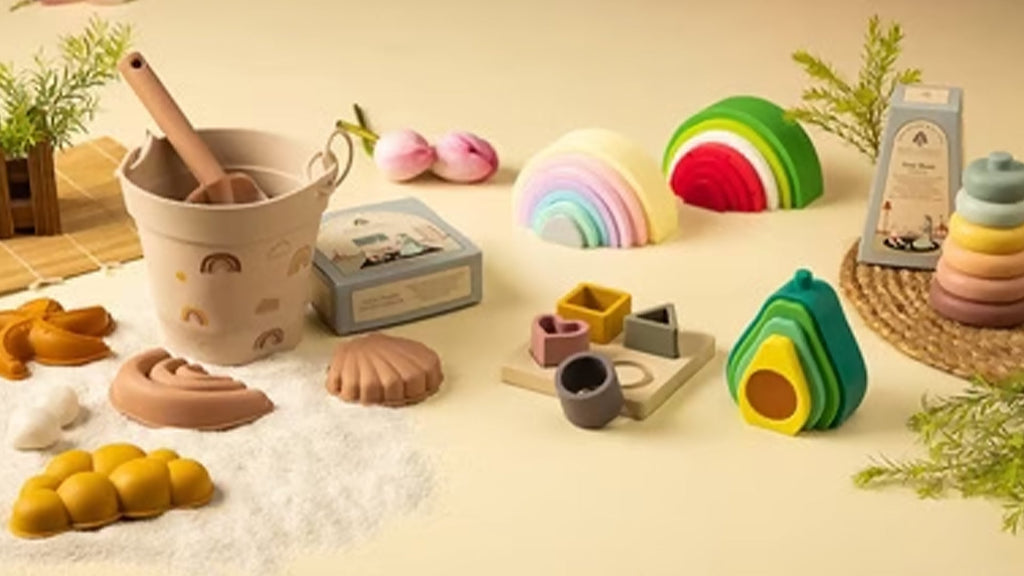
Types of Toys for Children by Age and Developmental Stage
Choosing the right toys for young children is more than just about fun—it's about supporting their growth and development. Toys play a crucial role in helping children learn about the world, develop new skills, and spark their imagination. However, with so many options available, it can be hard to know which toys are best for your child at each stage of their development. In this blog, we'll explore different types of toys that are ideal for young children based on their age and developmental stage.
Toys for Newborns to 6 Months: Exploring Senses
In the first six months of life, babies are just beginning to explore the world around them. At this stage, they are developing their senses, such as sight, sound, and touch. Toys that stimulate these senses are ideal.
Soft Toys:
Soft toys are perfect for newborns. They provide comfort and are safe for babies to touch and cuddle. Look for toys with different textures to help your baby explore the sense of touch. Soft toys like Mr. Monkey Soft Toy and the Lady Elph Soft Toy are loved by a lot of kids.
Baby Rattles:
Rattles are another great option for this age group. They are easy for little hands to grasp and shake, making them a fun way to explore sound. Baby rattles can also help develop motor skills as your baby learns to hold and move the rattle.
At this stage, it's important to choose toys that are safe, with no small parts that could be a choking hazard. Soft toys and rattles made from non-toxic materials are the best choices.
Toys for 6 to 12 Months: Developing Motor Skills
Between 6 and 12 months, babies become more active and start to develop their motor skills. They learn to sit up, crawl, and eventually take their first steps. Toys that encourage movement and coordination are ideal for this stage.
Spinning Lattu:
The spinning lattu is a traditional toy that can be a lot of fun for babies who are beginning to sit up. While your baby may not be able to spin the lattu on their own just yet, they will enjoy watching it spin. This toy helps develop hand-eye coordination as your baby learns to reach out and interact with it.
Stacking Toys:
Stacking toys, such as rings or blocks, are great for developing fine motor skills. Your baby will enjoy stacking the pieces and knocking them over, which also helps them understand cause and effect.
As babies become more mobile, they also enjoy toys that they can push or pull. These types of toys encourage walking and help develop balance and coordination.
Toys for 12 to 24 Months: Encouraging Problem Solving
From 12 to 24 months, toddlers are curious and eager to explore. They start to solve simple problems and understand how things work. Toys that encourage problem-solving and creativity are great for this age group.
Abacus Baby Wooden Toy:
The Abacus Baby Wooden Toy is a classic educational toy that helps toddlers learn to count and develop their fine motor skills. The bright colors and moving beads capture their attention, and as they slide the beads back and forth, they start to grasp the concept of counting.
Shape Sorters:
Shape sorters are another fantastic toy for this stage. They help toddlers learn about different shapes and sizes while also developing their problem-solving skills as they figure out which shape fits into which hole.
Toddlers also enjoy toys that let them mimic adult activities, like toy kitchens or tool sets. These toys allow them to engage in pretend play, which is important for developing imagination and social skills.
Toys for 2 to 3 Years: Building Imagination
As children enter their toddler years, their imagination begins to blossom. They enjoy playing pretend and exploring new roles. Toys that encourage imaginative play and creativity are perfect for this stage.
Soft Dolls or Animals:
Soft dolls or stuffed animals can become your child's favourite companions. They will enjoy playing house, caring for their dolls or animals, and even taking them on adventures. This type of play helps develop empathy and social skills.
Building Blocks:
Building blocks are a staple for this age group. They allow children to create structures and explore their creativity. Whether they are building towers, houses, or their own imaginative creations, blocks provide endless possibilities for play.
Art Supplies:
Simple art supplies, like crayons, colouring books, and playdough, are also great for toddlers. These tools help them express themselves creatively and develop fine motor skills.
Toys for 3 to 5 Years: Enhancing Learning and Coordination
By the time children are 3 to 5 years old, they are ready for toys that challenge their growing minds and bodies. At this stage, they enjoy activities that involve learning, coordination, and social interaction.
Puzzles:
Puzzles are fantastic for enhancing problem-solving skills and hand-eye coordination. Start with simple puzzles with large pieces and gradually move to more complex ones as your child's skills develop.
Sports Equipment:
Simple sports equipment, like a ball or a small basketball hoop, encourages physical activity and helps develop coordination. Playing sports also teaches children about teamwork and following rules.
Educational Games:
Educational games that teach letters, numbers, and shapes are also popular with this age group. These games make learning fun and prepare children for school.
Choosing the right toys for your child's age and developmental stage is a wonderful way to support their growth and learning journey. But remember, toys are just one part of the equation. Your involvement and interaction with your child during playtime are equally important. Playing together not only strengthens your bond but also enhances their learning experience. So, whether it's spinning a lattu or stacking blocks, make playtime a special time to connect, learn, and create lasting memories.
Bonus Tip:
Rotate your child's toys every few weeks. This keeps their interest alive and allows them to discover new ways to play with familiar items, further boosting their creativity and cognitive skills.
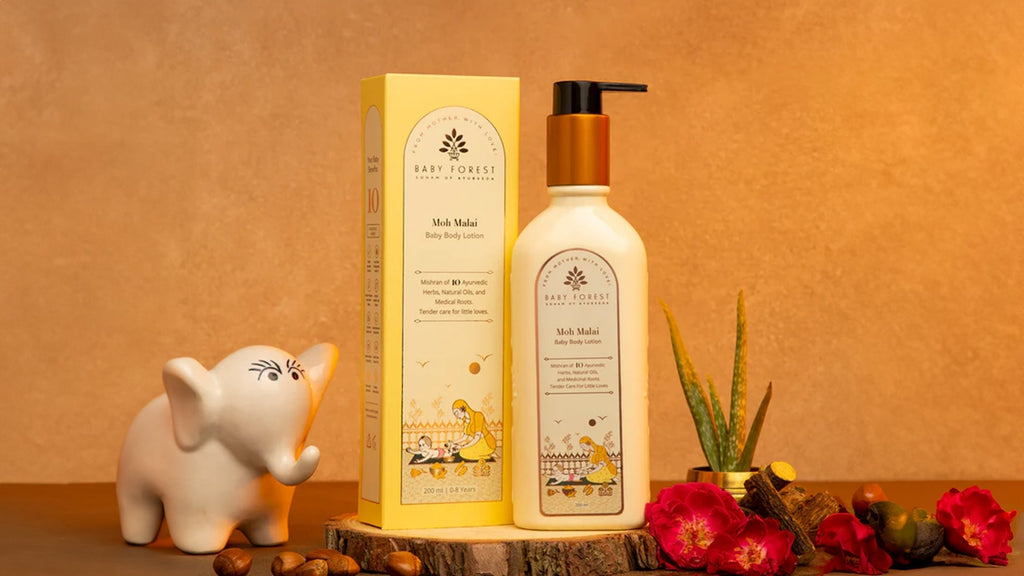
The Benefits of Using Organic Baby Lotion
When it comes to caring for your baby's delicate skin, choosing the right products is important. Organic baby lotions are increasingly popular among new parents who seek the safest and most natural options. These lotions are crafted from plant-derived ingredients, free from harsh chemicals, and are gentle on the skin, making them ideal for daily use. Here's why organic baby lotion should be a staple in your childcare routine, along with an overview of some key ingredients that offer incredible benefits.
Why Choose Organic Baby Lotion?
Organic baby body lotions are made with natural ingredients that are not only safe but also beneficial for your baby's skin. These products are typically vegan, cruelty-free, derma-safe, and devoid of synthetic fragrances and dyes, making them a wholesome choice for your little one. They are formulated to provide moisture, protect sensitive skin, and prevent common skin issues like dryness and diaper rashes.
Gentle on Sensitive Skin
Babies' skin is thinner and more absorbent than adults', making it sensitive to chemicals found in conventional lotions. Organic baby body lotions are crafted without harsh chemicals, synthetic fragrances, or dyes, common irritants that can disrupt the skin's natural balance and lead to dryness or rashes. Instead, organic lotions utilize natural ingredients that are far less likely to cause allergic reactions, ensuring a gentler approach to skincare.
Enhanced Moisturization
Organic lotions are typically formulated with natural oils and butter, such as coconut oil, almond oil, and shea butter, which are known for their deep moisturizing properties. Unlike petroleum-based ingredients commonly found in non-organic lotions, these natural moisturizers support the skin's ability to hydrate and repair itself. This is crucial in preventing dryness and maintaining the softness and elasticity of your baby's skin.
Free from Harmful Additives
One of the main benefits of using organic baby lotion is the absence of potentially harmful additives. Organic products do not contain parabens, phthalates, or sulfates, which can interfere with the body's natural hormones and cause long-term health issues. By choosing organic, parents can avoid exposing their babies to these unnecessary risks.
Eco-Friendly
Choosing organic baby lotion is not only good for your baby but also better for the environment. Organic farming of the ingredients in these lotions minimizes pollution, conserves water, reduces soil erosion, and uses less energy. Furthermore, farming techniques enhance soil fertility and reduce toxins in the environment, making organic products a more sustainable choice.
Key Ingredients to Look for and Their Benefits
-
Shea Makkhanam (Shea Butter)
Known for its rich moisturizing properties, shea butter is a superb ingredient for baby lotions. It helps to soothe dry skin and creates a barrier that locks in moisture, which is essential for keeping your baby's skin soft and hydrated. -
Tila Tailam (Sesame Oil)
This oil is highly nourishing and is known for its antibacterial properties. It's particularly effective in protecting baby skin against common pathogens, making it a great choice for preventing diaper rash. -
Narikel Tailam (Coconut Oil)
Coconut oil is celebrated for its deep moisturizing capabilities and is gentle enough for sensitive baby skin. It helps to soothe irritation, moisturize deeply, and enhance skin barrier function. -
Badam Vatadha (Almond Oil)
Rich in vitamins E and D, as well as minerals such as calcium and magnesium, almond oil not only supports skin health but also promotes heart and bone health in babies. -
Anar Dadim (Pomegranate Seed Oil)
This less common but highly beneficial oil is packed with antioxidants, which protect the skin from environmental stressors. It also helps heal, particularly soothing skin inflammations and eczema.
The Moh Malai Baby Body Lotions includes other botanical extracts like Ghrit Kumari (Aloe Vera), which provides exceptional soothing and healing properties, especially in healing minor rashes and supporting skin regeneration. Neemba (Neem Extract) is another excellent addition due to its renowned medicinal properties that help treat and prevent skin irritations.
Choosing the Right Organic Baby Lotion
When selecting an organic baby lotion, it's important to look at the ingredients list. Opt for products that are free from parabens, sulfates, phthalates, and artificial fragrances. Ensure the product is certified organic to guarantee that the ingredients used meet stringent organic standards.
Incorporating Organic Lotion into Your Baby's Skincare Routine
Using organic baby lotion can be part of your daily routine. Apply lotion after bath time to lock in moisture and any time you notice your baby's skin becoming a bit dry. Gentle massages with these lotions can not only moisturize but also provide a soothing bonding experience with your baby.
With ingredients that are as effective as they are safe, baby lotions provide peace of mind to parents and comfort to babies. Remember, the skin is the largest organ and taking care of it from the start sets the foundation for healthy skin for years to come. Choose wisely, and let the natural goodness of organic baby lotions nurture your baby's skin the way nature intended.
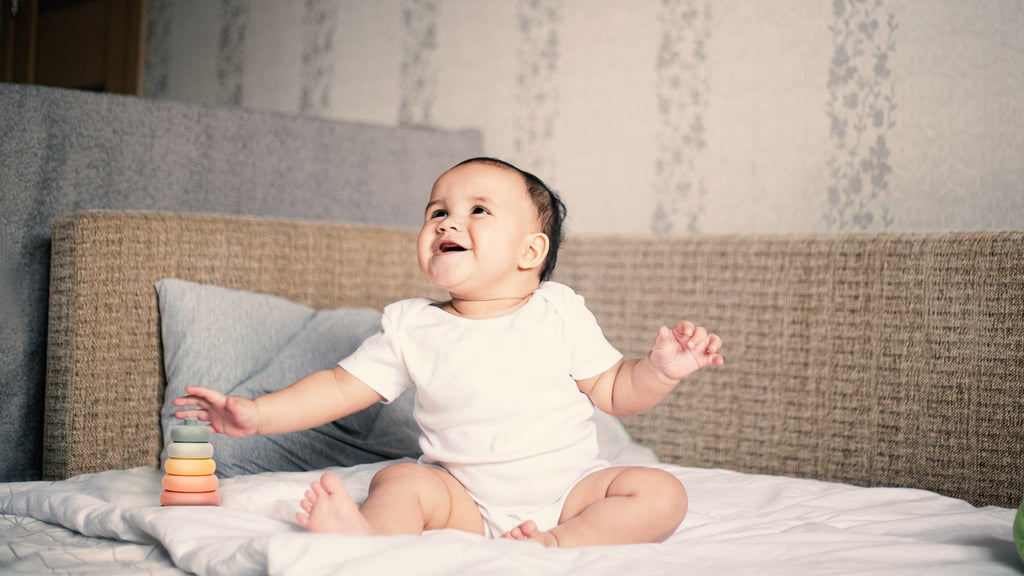
A Guide to Fostering Your Child’s Growth with Ayurvedic I...
As parents, we’re always looking for ways to nurture and guide our babies' development. From the very first moments of life, their growth is shaped by their experiences—particularly how they play and interact with the world around them. One of the oldest systems of medicine, Ayurveda, has long recognized the importance of this early development.
Known as Kaumarabhritya or Bala Chikitsa, Ayurveda focuses on all aspects of a child's well-being, from nutrition to proper posture, and even how to explore the world. This includes a deep understanding of the role of play in an infant’s life. For new parents, especially, it can be difficult to know what is best for your baby. Ayurveda, however, provides clear guidance that can help you nurture their development in a way that promotes both physical and cognitive growth.
‘Kreeda’ in Ayurveda: The Importance of Play for Your Baby
In Ayurveda, play is seen as an essential part of a baby’s life. It is how they interact with the world and learn about it. Play isn’t just about choosing the right toys or the right age for play—it is about understanding how play shapes the development of your little one. Ayurveda refers to play as Kreeda, which is considered a fundamental right for every child. Through play, babies experience the first feeling of enjoyment and begin to cultivate their creativity and imagination.
For example, when babies accomplish a task or struggle to do something, they are developing essential traits in both their physical and cognitive development. Babies use play as a medium of expression long before they develop language skills. Have you ever seen your baby throw something when they’re frustrated or curl their fingers around a toy they like? Or perhaps they rub their gums on a toy when they’re teething, using play as a way to relieve irritation. These actions may seem simple, but they are significant steps in their emotional and physical growth.
How Developmental Toys Aid in Baby’s Growth
Choosing the right developmental toys is crucial to a baby’s progress. Infants, especially, are highly influenced by the toys they interact with. These toys are not only fun but can help stimulate mental and motor development. Here are five key qualities to look for in the best toys for your child’s development.
1. Vichitrani (Variety)
A variety of shapes, sizes, and colours can help attract your baby’s attention. Babies are naturally drawn to visually stimulating toys, and a colourful, diverse toy encourages exploration and creativity. Look for infant toys for development that offer a range of textures and colours to keep them intrigued and engaged. This is a great way to keep your baby mentally stimulated and entertained as they grow.
2. Ramanya (Good Looking)
Toys should bring out positive feelings in babies. A toy that looks pleasant and inviting can make a big difference in how your baby feels while playing. Infant learning toys that are aesthetically pleasing and calming help to build a positive connection to playtime. Avoid toys that show aggression or violence, as these can negatively impact your baby’s emotional development.
3. Aguru (Lightweight and Handy)
When choosing toys, ensure they are light enough for your baby to handle comfortably. A heavy toy may frustrate them and limit their ability to engage in meaningful play. Lightweight toys are easier for babies to manipulate, promoting hand-eye coordination and offering them the chance to demonstrate their creativity. Whether it's a plush toy or a building block, the best toys for 2-year-olds should always be easy for them to pick up, hold, and explore.
4. Ateekshnaani (No Sharp Edges)
Safety is of utmost importance, especially for infants who tend to put everything in their mouths. Make sure that the toys your baby plays with are free from sharp edges or tiny parts that could be a choking hazard. Toys with smooth surfaces and no sharp edges are ideal for babies at any age. Developmental toys should always be safe and age appropriate.
5. Ruchi (Curiosity)
Finally, the toy should foster curiosity. Babies are naturally curious, and their toys should reflect this curiosity. Look for toys that stimulate their cognitive development based on their age. For example, a toddler might enjoy a toy that moves or makes sounds, while a newborn might benefit from a soft toy with different textures. Infant toys for development should always encourage your baby to explore and learn in a fun and engaging way.
Safe Toys and Modern Play
As much as babies are drawn to plastic toys with their vibrant colours, it’s essential to understand that plastic toys can come with hidden dangers. While they are attractive, they may contain harmful chemicals that aren’t safe for your baby to chew on or interact with. As a parent, you may have experienced the heartache of hearing your baby cry over a toy they love but knowing deep down that it may not be the safest option.
Ayurveda offers an answer to this dilemma through the Kashyapa Samhita, which includes guidance on safe materials for toys, especially for infants. While these materials may not always fit the modern aesthetics of toys, they provide the safety and natural quality that your baby needs. Brands like Baby Forest have worked hard to bridge this gap, offering toys made from food-grade materials that are safe to chew, easy to handle, and free of chemicals.
By choosing these infant learning toys, you are not only providing safe options for your baby but also ensuring that they are learning and enjoying themselves simultaneously. These toys are designed to help your child reach developmental milestones in a secure, fun way.
Conclusion: Nurture Your Baby’s Growth with the Right Toys
As new parents, it’s important to be well-informed when selecting toys for your little one. By understanding the principles of Kaumarabhritya and Ayurveda’s approach to development, you can make choices that support your baby’s growth. Whether you’re looking for developmental toys that spark curiosity or encourage physical activity, the key is to choose items that promote both safety and learning.
Remember, the best toys aren’t just the ones that entertain—they are the ones that help shape your baby’s mind, body, and spirit. Choosing the right toys can make all the difference in how your baby experiences their world. With a little research and the wisdom of Ayurveda on your side, you’ll be well on your way to helping your baby thrive through play.



